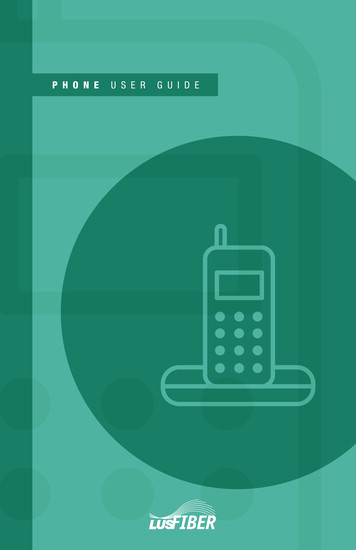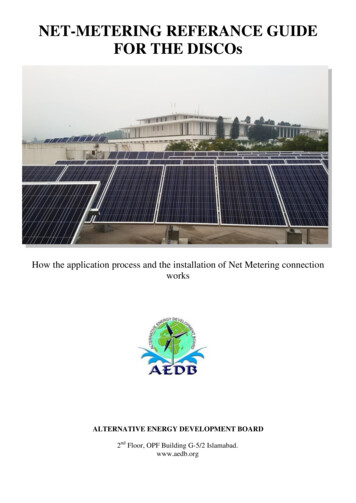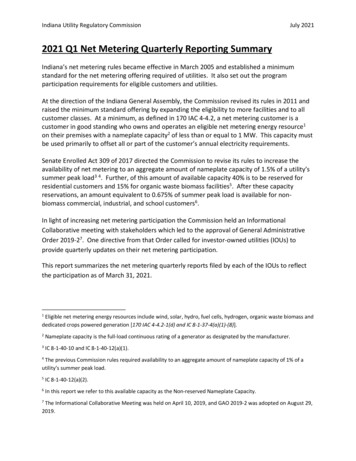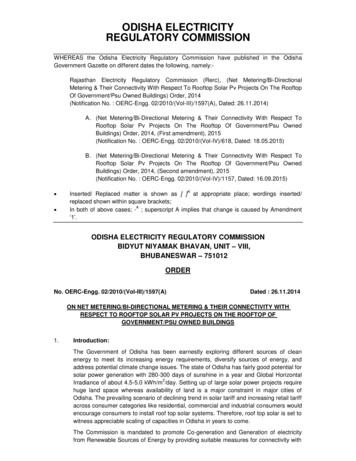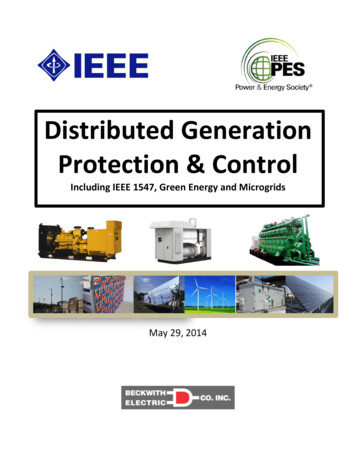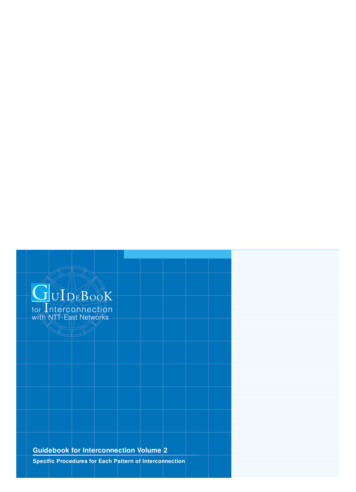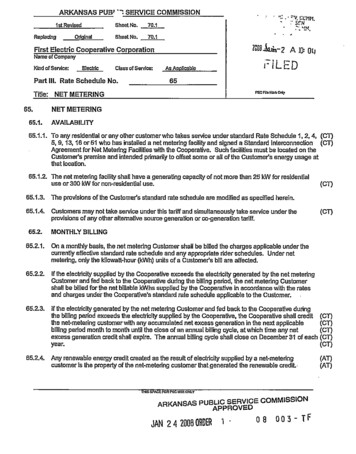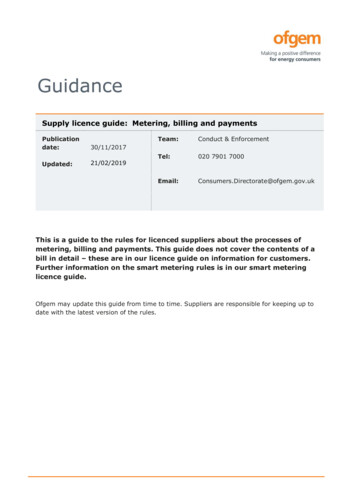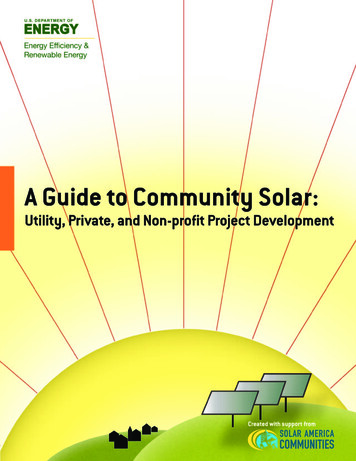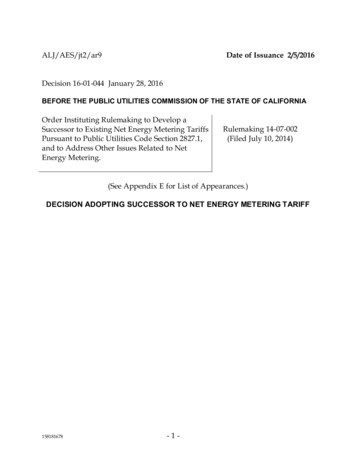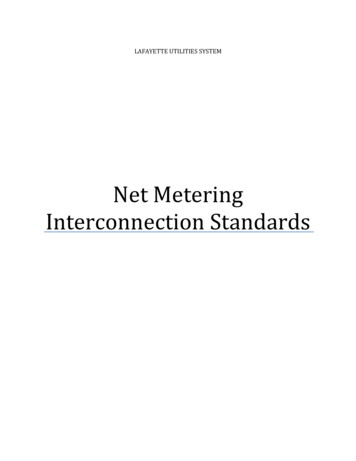
Transcription
LAFAYETTE UTILITIES SYSTEMNet MeteringInterconnection Standards
Lafayette Utilities SystemNet Metering Interconnection StandardsRev. 4Effective Date: 8/1/15Table of Contents1Introduction . 21.11.2Purpose . 2Scope . 22Definitions . 43Details . .113.123.12.13.12.23.12.33.133.143.153.16Available Voltage Systems . 6Reasons for Disconnection from the Electric Secondary Delivery System . 6Electrical Current and Voltage of Existing Service . 6System Changes . 6Lafayette Utilities System Changes to Electric Distribution System . 6Net Metering Customer Changes to Interconnection . 6Allowable Tie Points . 7Energy Flow during Emergencies . 7Types of Allowed Generators. 7General Interconnection Requirements . 7Net Metering Customer’s Equipment and Interconnection Standards . 7Rating of Net Metering Customer’s Equipment. 7Protection of Net Metering Customer’s Equipment . 7Required Drawings . 8Changes to Lafayette Utilities System Facilities . 8Power Factor. 8Reactive Power Requirements. 8Voltage Surges or Sags. 8Voltage Flicker . 9Frequency . 9Harmonics . 9Inspection Prior to Operations and Additional Requirements. 9Responsibility for Net Metering Customer’s Operations . 10Responsibility for Net Metering Customer’s Annual Maintenance . 10Protection/Interface Requirements . 10Changes to Lafayette Utilities System Fault Interruption Equipment . 10Tests of the Net Metering Customer’s Equipment . 10Requirements for Specific Technologies . 11Susceptibility to Transmission Faults. 11Synchronizing Requirements . 11Metering Requirements . 11Standard Interconnection Requirements . 114References . 12Net Metering Flow Sheets and Diagrams . 13Annex A Net Metering Interconnection ApplicationAnnex B Net Metering Interconnection AgreementAnnex C NEC 2011 Labeling RequirementsPage 1
Lafayette Utilities SystemNet Metering Interconnection Standards1Introduction1.1PurposeRev. 4Effective Date: 8/1/15The purpose of these interconnection standards for Qualified Small Customer / QF Energy Facilitiesis to describe the requirements and procedures for safe and effective connection and operation ofSmall electric generators on the LUS Electric Distribution System.A Net Metering Customer may operate an Electric Generator at 60 Hertz (Hz), single- or threephase at voltages up to and including 480V in parallel with LUS’s Electric Secondary DeliverySystem pursuant to an Interconnection Agreement, provided that the equipment meets or exceedsthe requirements of this standard. Any interconnection request above the 480V level will beconsidered on a case by case basis. Contact Lafayette Utilities Chief Electrical Engineer to discussany interconnection requests of this type.Two objectives must be met to arrive at compliance by the proposed installation:1. Safety - The Net Metering Customer’s Renewable Energy Facility will be held to the sameStandard of Care, as LUS is required to maintain. In addition, the safety of the general public andthe personnel and equipment of LUS shall in no way be reduced or impaired as a result of theInterconnection.a. The Net Metering Customer’s Renewable Energy Facility shall be equipped with ProtectiveFunctions designed to prevent the Renewable Energy Facility from being connected to a deenergized circuit owned by LUS.b. The Net Metering Customer’s Renewable Energy Facility shall be equipped with thenecessary Protective Functions designed to prevent connection or Parallel Operation of theNet Metering Customer’s facility with the Electric Secondary Delivery System unless theElectric Secondary Delivery System service voltage and frequency are of normal magnitude.The design of some systems provides these functions without adding equipment at the PCC.Each system not providing additional devices at the PCC must be shown to be capable ofthese functions.2. Customer Impact - The reliability, availability, and Quality of Service to LUS’s other Customersshall not be diminished or impaired as a result of the Interconnection.This standard describes typical connection requirements. Some installations, however, may requiremore extensive Interconnection Facilities, and will be addressed on a case by case basis. This ismost likely to be required when several Customers desire to connect Renewable Energy Facilitiesto the same transformer or on the same distribution feeder.1.2ScopeCustomer Renewable Energy Facilities may be installed within LUS’s service area on the NetMetering Customer’s side of the meter. These facilities will be connected to the Electric SecondaryDelivery System when the Electric Secondary Delivery System is operating under normalconditions. The Net Metering Customer’s entire load or any part of it may be supplied with energyby the Renewable Energy Facility. LUS’s facilities will be available to handle the Net MeteringCustomer’s entire load as needed.Applications for Net Metering are limited to:ResidentialNon-ResidentialMaximum Generator SizeMaximum Generator SizeTotalTotal25 kW100 kWType of FuelRenewable fuel as solar, windor qualified biomassPage 2
Lafayette Utilities SystemNet Metering Interconnection StandardsRev. 4Effective Date: 8/1/15Generators that do not qualify for Net Metering and desire interconnection shall contact LUS’s ChiefElectrical Engineer.The provisions contained in this document are the minimum requirements for safe and effectiveInterconnection and operation of Net Metering Facilities operating in parallel with LUS’s ElectricSecondary Delivery System.Page 3
Lafayette Utilities SystemNet Metering Interconnection Standards2Rev. 4Effective Date: 8/1/15DefinitionsAbnormal Operating Conditions – A situation in which LUS is operating the Electric DistributionSystem and the Electric Secondary Delivery System in a manner inconsistent with normalconfiguration or under conditions that do not normally exist. Examples of abnormal operatingconditions are times when LUS must switch distribution feeder circuits out of use for repairs andswitch other alternate feeders into use to deliver energy to Customers.Customer - Any entity interconnected to LUS’s Electric Secondary Delivery System who takeselectric service under one of LUS’s rate schedules.Displaced Load – The Net Metering Customer’s entire electrical requirement or a portion of it that,except for the output of the Net Metering Customer’s Renewable Energy Facilities, would have beenserved by LUS.Electric Distribution System – All of LUS’s wires, equipment, and facilities having a voltage of13.8kV or below including the Electric Secondary Delivery SystemElectric Secondary Delivery System - LUS’s wires, equipment, and facilities having a voltage of 480Vor below to which the Net Metering Customer’s Facility is interconnected (the Electric SecondaryDelivery System is a subset of the Electric Distribution System).ETrakIt – See LCG Online Permit and Project Search EngineInterconnection - The physical connection of facilities to the Electric Secondary Delivery System sothat Parallel Operation can occur.Interconnection Agreement - The Standard Interconnection Agreement for Net Metering Facilitiesapproved by the Lafayette Public Utilities Authority and Lafayette City Parish Council.Interconnection Facilities - All facilities installed solely to interconnect the Net Metering Customer’ssystem with that of LUS to facilitate the exchange of power between the Net Metering Customer’sRenewable Energy Facilities and LUS’s power system including, but not limited to, connection,transmission, distribution, engineering, transformation, switching, metering, and safety equipment.Interconnection Facilities shall include any additions and/or modifications to LUS’s system deemedby LUS to be necessary.LUS – Lafayette Utilities SystemLCG Online Permit and Project Search Engine – An online permit tracking database accessible to thepublic used to track permits and 2/Index.aspxNetwork Service - Two or more primary distribution feeder sources electrically connected on thesecondary (or low voltage) side to form one power source for one or more Customers. Thisconfiguration is designed to maintain service to the Customers even after the loss of one of theseprimary distribution feeder sources.Net Metering Customer - Any Customer that takes service under LUS’s net metering provisions.Net Metering Facility - The hardware and software installed to measure the energy flow both intoand out of the Net Metering Customer’s facilities for the purpose of determining the usage forbilling, if any.Page 4
Lafayette Utilities SystemNet Metering Interconnection StandardsRev. 4Effective Date: 8/1/15Parallel Operation - The operation of Renewable Energy Facilities by a Net Metering Customerwhile the Net Metering Customer’s facilities are physically and electrically interconnected to LUS’sElectric Secondary Delivery System.Point of Common Coupling (PCC) - The point where transfer of any electric power between theCustomer’s facilities and LUS’s Electric Secondary Delivery System takes place, normally at thepoint of attachment.Protective Function - Unsafe Operating Conditions shall be prevented from occurring before,during, and after the Interconnection of a Renewable Energy Facility with LUS’s Electric SecondaryDelivery System. This system typically uses hardware (including switching devices), relayprotection schemes and software that and shall be designed to isolate the Net Metering Customer’sRenewable Energy Facility or to disconnect it from LUS’s Electric Secondary Delivery System underUnsafe Operating Conditions or outages.Quality of Service - An operating state of the Electric Secondary Delivery System that providesusable power to a Customer. This state of usable power includes the parameters specified forpower factor, voltage surges and sags, voltage flicker, frequency and harmonics. For moreinformation on these parameters, refer to the first page of this standard for these sections.Renewable Energy Facility - A system of hardware and software by which electric energy isgenerated using sun, wind, or biomass products as the source and is allowed to be interconnectedto LUS’s Electric Secondary Delivery System.Stabilized - The Electric Secondary Delivery System is considered stabilized when, following adisturbance, the system returns to the normal range of voltage and frequency for duration of fiveminutes.Standard of Care - A term defining the level of awareness to maintain workplace and public safetyin the design, installation and operation of facilities which generate power.System Protection Facilities - The equipment required to protect LUS’s system and its otherCustomers’ facilities from Unsafe Operating Conditions occurring at the Net Metering Customer’sRenewable Energy Facilities. The protection requirements shall be met at the PCC, although thedevices and functions providing the Protective Functions can be located elsewhere.Unsafe Operating Conditions - A situation that if left uncorrected would result in: (1) harm to anypersonnel or damage to any equipment, (2) unacceptable system stability or, (3) operation outsideestablished parameters affecting the Quality of Service to other Customers connected to the ElectricSecondary Delivery System.Page 5
Lafayette Utilities SystemNet Metering Interconnection StandardsRev. 4Effective Date: 8/1/153Details3.1Available Voltage Systems3.2Reasons for Disconnection from the Electric Secondary Delivery SystemLUS’s Electric Secondary Delivery Systems available for parallel generation operations are ofgrounded wye or closed delta configurations. Generally, all secondary voltage levels from 120/240V to 480 V single-phase or three-phase (except open-delta and open-wye) are available forInterconnection. Open-delta and open-wye secondary voltage configurations require specialevaluation prior to Interconnection. The voltage level available for connecting the Customer’sRenewable Energy Facility in parallel with the system depends on the desired location on LUS’sElectric Secondary Distribution System and the size of the Net Metering Customer’s RenewableEnergy Facility.LUS may disconnect the Net Metering Customer’s Renewable Energy Facilities from the ElectricSecondary Delivery System under the following conditions:1. Upon termination of the Interconnection Agreement;2. Non-compliance of the Net Metering Customer’s facility with any of the requirements in thisdocument;3. System emergency –a. LUS may temporarily disconnect a Net Metering Customer’s facility without prior writtennotice in cases where continued Interconnection will endanger persons or property;b. During the forced outage of the Electric Distribution System, LUS shall have the right totemporarily disconnect a Net Metering Customer’s facility to make immediate repairs on theElectric Distribution System;4. During routine maintenance, repairs, and modifications to LUS’s Electric Distribution System;5. Lack of approved Interconnection Agreement – In order to interconnect the Net MeteringCustomer’s Renewable Energy Facility to LUS’s Electric Secondary Delivery System, a NetMetering Customer must first submit to LUS an executed Standard Interconnection Agreementfor Net Metering. LUS may refuse to connect or may disconnect the Net Metering Customer’sfacility if such agreement has not been received and approved.When possible, LUS will provide the Net Metering Customer with reasonable notice ofdisconnection and will reconnect the Net Metering Customer as quickly as reasonably practical.3.3Electrical Current and Voltage of Existing Service3.4System Changes3.4.1Lafayette Utilities System Changes to Electric Distribution System3.4.2Net Metering Customer Changes to InterconnectionLUS shall ascertain if the proposed Renewable Energy Facility output exceeds the current carryingcapability and matches the voltage of the existing secondary service wires and transformers. LUSwill advise Customer of any Customer costs which may be incurred if upgrades are required and thevoltage and load carrying ability of the existing service.The Electric Distribution System is a dynamic and changing system. If LUS changes the distributionvoltage, the Net Metering Customer will be responsible for paying for all modifications to the NetMetering Customer’s facilities required for reconnecting to LUS’s reconfigured Electric SecondaryDelivery System. LUS will notify the Net Metering Customer of reconfiguration programs.The Net Metering Customer shall notify and obtain prior approval from LUS prior to performingany modifications to the interconnecting scheme.Page 6
Lafayette Utilities SystemNet Metering Interconnection StandardsRev. 4Effective Date: 8/1/153.5Allowable Tie Points3.6Energy Flow during Emergencies3.7Types of Allowed Generators3.8General Interconnection Requirements3.8.1Net Metering Customer’s Equipment and Interconnection StandardsOne tie point between the Net Metering Customer’s facilities and LUS’s Electric Secondary DeliverySystem will be allowed. This point will be the Point of Common Coupling (PCC).Power flow from or to a Net Metering Customer’s facilities during periods of system emergenciesmay be discontinued. LUS shall pay for kWh actually received, not for Customer potential capacity.Single or three-phase alternating current generating units may be operated in parallel with theElectric Secondary Delivery System. They may be synchronous generators, induction generators, orinverter-controlled systems. Direct-current generation shall not be connected to LUS’s ElectricSecondary Delivery System.The Net Metering Customer’s Renewable Energy Facility shall meet the technical requirements asprescribed in this section and in IEEE 1547, latest version.The Net Metering Customer’s Renewable Energy Facilities and Interconnection installation mustmeet all applicable national, state, and local construction and safety codes. The Net MeteringCustomer shall be responsible for the design, installation, operation and maintenance of allequipment and facilities installed or that will be installed on the Net Metering Customer’s side ofthe PCC specified by the parties involved. Such design shall meet the latest standards of Institute ofElectrical and Electronic Engineers, National Electric Manufacturers Association, American NationalStandards Institute, National Electric Code, other national codes and local codes pertaining to thedesign and construction of electrical facilities in effect at the time of installation. The facility shall besubject to the requirements of all authorities having jurisdiction and shall comply with allapplicable codes and ordinances. A visible opening General Duty, Single Throw, NEMA 3R ACdisconnect, which is accessible to and lockable by LUS personnel at all hours without notice,shall be furnished and installed by the Customer. This disconnect shall be located within tenfeet (10’) of the customer meter base and shall disconnect the Customer’s Renewable EnergyFacility from the Electric Distribution System. This disconnect must be labeled as per NECrequirements.The meter base must be labeled as per NEC requirements. In addition to NEC requirements, themeter base must be labeled with the following criteria: Directional arrow pointing towards AC disconnect Distance to AC disconnect AC output, in kW, of generation system.3.8.2Rating of Net Metering Customer’s Equipment3.8.3Protection of Net Metering Customer’s EquipmentThe equipment selected by the Net Metering Customer shall be rated for continuous ParallelOperation with LUS’s system. Renewable Energy Facilities that are intended to provide theCustomer with power during periods when LUS’s facilities are unavailable shall be equipped withan automatic transfer switch to prevent energizing a non-energized LUS Electric SecondaryDelivery System consistent with sections 3.12.3 and 3.8.1 of this policy.The Net Metering Customer will be responsible for protecting its facilities in such a manner thatElectric Secondary Delivery System outages, short circuits or other disturbances, including zerosequence currents and ferroresonant over-voltages, do not damage the Net Metering Customer’sfacilities. The Net Metering Customer’s protective equipment shall be installed to prevent thePage 7
Lafayette Utilities SystemNet Metering Interconnection StandardsRev. 4Effective Date: 8/1/15Renewable Energy Facility from causing unnecessary tripping of the Electric Distribution Systembreakers that would affect the Electric Distribution System’s ability to provide reliable service toother Customers.3.8.4Required Drawings3.8.5Changes to Lafayette Utilities System Facilities3.8.6Power Factor3.8.7Reactive Power Requirements3.8.8Voltage Surges or SagsAdequate drawings of the Net Metering Customer’s proposed Renewable Energy Facility must besubmitted to LUS for review during the planning stage. They shall include, at a minimum: A complete one line diagram originating at the generation source and ending at the utilitymeter, including all equipment and Over-Current Protection Device (OCPD) ratings, directlyconnected to or associated with the Renewable Energy Facility Site address Generator/Inverter manufacturer, model number and quantity Solar panel manufacturer, model number and quantity and number of strings/panels per string AC disconnect distance to meter baseAdditional drawings may be required on a case by case basis.The total cost of any additional equipment that must be installed by LUS on its Electric DistributionSystem to allow Parallel Operation must be paid for by the Net Metering Customer, including thetransformers and any facilities which must be added due to increased fault current or specialoperating conditions.The power factor of the Customer Renewable Energy Facility at the PCC shall be according to theappropriate rate schedule for this installation. The presence of the Customer Renewable EnergyFacility shall not cause the power factor to be lower than it was prior to installation and operationof the Customer Renewable Energy Facility.Net Metering Customer’s Renewable Energy Facility shall normally be responsible for supplying thefacility’s own reactive power as required by the load to which it supplies power.The Net Metering Customer will operate its Renewable Energy Facility in such a manner that thevoltage levels on the Electric Distribution System are in the same range ( 5% from nominalvoltage) as if the facilities were not connected to LUS’s system. The Net Metering Customer shall beresponsible for any damages to the Net Metering Customer’s facilities, and shall be liable for anydamages to LUS’s facilities or the facilities of other Customers due to any under voltage or overvoltage contribution from the Customer Renewable Energy Facility. The Customer shall provide anautomatic method of disconnecting the generating equipment from the Electric Secondary DeliverySystem consistent with IEEE Standard 1547a-2014 Table 1.a–b–Default SettingsaVoltage rangeClearing times (s)(% of base voltageb)V 450.1645 V 60160 V 882110 V 1201V 1200.16Clearing time: adjustable up to andincluding (s)0.161121130.16Under mutual agreement between the EPS and DR operators, other static or dynamic voltage and clearing time trip settings shall be permitted.Base voltages are nominal voltages stated in ANSI C84.1-2011, Table 1.(Source IEEE Standard 1547a-2014 Table 1)Page 8
Lafayette Utilities SystemNet Metering Interconnection Standards3.8.9Rev. 4Effective Date: 8/1/15Voltage FlickerThe Customer Renewable Energy Facility shall not create objectionable flicker for LUS’s otherCustomers. As a guide to identifying objectionable flicker the “Border Line of Irritation” curve, IEEEStandard 141-1993 Figure 3-8, is included below. The creation of objectionable flicker shall resultin disconnection by LUS until such time that all objectionable flicker problems are corrected.3.8.10 Frequency(Source: IEEE Standard 141-1993 Figure 3-8)When the operating frequency of the Customer’s generating equipment deviates from the 60 Hzbase, as outlined in IEEE Standard 1547a-2014 Table 2, the generating equipment shall beautomatically disconnected from the Electric Secondary Delivery System:Default SettingsFunctionFrequency (Hz)Clearing Time (s)UF1UF2OF1OF2 57 59.5 60.5 620.16220.16Ranges of AdjustabilityClearing Time (s)Frequency (Hz)adjustable up to andincluding56-601056-6030060-6430060-6410(Source IEEE Standard 1547a-2014 Table 2)LUS may require the Customer to wait up to five minutes to reconnect after the Electric SecondaryDelivery System voltage and frequency return to normal range and the system is stabilized. ConsultLUS for details. (IEEE 1547 4.2.6)3.8.11 HarmonicsIn accordance with IEEE Standard 519-2014, the total harmonic distortion (THD) voltage shall notexceed 8.0% of the fundamental 60 Hz frequency or 5.0% of the fundamental frequency for anyindividual harmonic when measured at the PCC.3.9Inspection Prior to Operations and Additional RequirementsLUS reserves the right to impose any herein described but unmet requirements and to makesubsequent final inspection before the Customer Renewable Energy Facility operates to verify thatall such unmet requirements have been satisfied. However, LUS has no actual or impliedresponsibility in this regard. The Net Metering Customer shall be responsible for making necessarychanges, at the Net Metering Customer’s expense, to the facility should such changes be required.Inspection by LUS of the Net Metering Customer’s equipment and Interconnection Facilities shallPage 9
Lafayette Utilities SystemNet Metering Interconnection StandardsRev. 4Effective Date: 8/1/15not constitute a determination by LUS of the continuing suitability of such equipment andInterconnection. An inspection by LUS shall in no way constitute a warranty or representation byLUS against future negligence, misuse, faulty repairs, or subsequently developing defects, and LUSassumes no responsibility or liability therefore.3.10Responsibility for Net Metering Customer’s Operations3.11Responsibility for Net Metering Customer’s Annual Maintenance3.12Protection/Interface RequirementsLUS is not responsible for proper operations of the Net Metering Customer’s Renewable EnergyFacility upon and after Interconnection to LUS’s Electric Secondary Delivery System.Annual maintenance of the Net Metering Customer’s facility is the Net Metering Customer’s soleresponsibility. The Net Metering Customer shall maintain records of such maintenance activities,which LUS may review at reasonable times. Such maintenance records shall be made available forLUS’s inspection upon request. LUS reserves the right to inspect the records, but has noresponsibilities for maintenance either actual or implied.Protecting both the Net Metering Customer’s facilities and LUS’s system are of great importance.Proper protective systems shall be established in the design phase and confirmed prior to start-upof the Net Metering Customer’s Renewable Energy Facility. An Interconnection between LUS andthe Net Metering Customer will not be allowed prior to the proper coordination of protectivedevices. The Net Metering Customer shall be responsible for providing to LUS the necessarydocumentation certifying that maintenance and testing have been satisfactorily performed.3.12.1 Changes to Lafayette Utilities System Fault Interruption EquipmentCustomer Renewable Energy Facilities that are installed on LUS’s Electric Secondary DeliverySystem will provide additional fault current to the Electric Distribution System. Thus, in specialcircumstances it is possible that the added facilities will necessitate the modification of the existingfault interrupting devices on the distribution feeder. The Net Metering Customer will beresponsible for paying the cost of these changes to LUS’s system. It is also possible that the addedfacilities will increase the available fault current on the Electric Distribution System beyond theinterrupting capability of the existing devices on the Electric Distribution System. The Net MeteringCustomer may be required to limit the fault current contribution from the Customer RenewableEnergy Facility. Should LUS also be required to make changes, the Net Metering Customer shall paythe cost of the required changes. These issues will be examined on a case-by-case basis.3.12.2 Tests of the Net Metering Customer’s EquipmentLUS reserves the right, but has no responsibility either actual or implied, to observe the NetMetering Customer’s tests and/or inspection of any of the Net Metering Customer’s protectiveequipment that is essential to the Interconnection, including relays, circuit breakers, protectivedevice
A Net Metering Customer may operate an Electric Generator at 60 Hertz (Hz), single- or three- phase at voltages up to and including 480V in parallel with 's Electric Secondary Delivery LUS System pursuant to an Interconnection Agreement, provided that the equipment meets or exceeds

